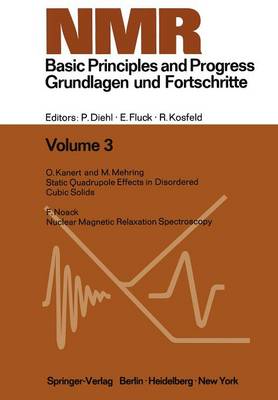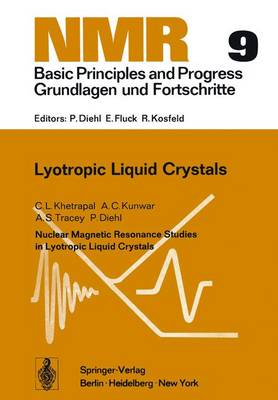NMR Basic Principles and Progress
4 primary works
Book 1
NMR Basic Principles and Progress. Grundlagen Und Fortschritte
by P Diehl, C. L. Khetrapal, and R. G. Jones
Published 1 January 1969
Nuclear magnetic resonance spectroscopy, which has evolved only within the last 20 years, has become one of the very important tools in chemistry and physics. The literature on its theory and application has grown immensely and a comprehensive and adequate treatment of all branches by one author, or even by several, becomes increasingly difficult. This series is planned to present articles written by experts working in various fields of nuclear magnetic resonance spectroscopy, and will contain review articles as well as progress reports and original work, its main aim, however, is to fill a gap, existing in literature, by publishing articles written by specialists, which take the reader from the introductory stage to the latest development in the field. The editors are grateful to the authors for the time and effort spent in writing the articles, and for their invaluable cooperation. The Editors Contents P. Diehl and C. L. Khetrapal NMR Studies of Molecules Oriented in the Nematic Phase of Liquid Crystais...1 R. G. Jones The Use of Symmetry in Nuclear Magnetic Resonance...97 NMR Studies of Molecules Oriented in the Nematic Phase of Liquid Crystals P. DIEHL and C. L.
KHETRAPAL * Department of Physics, University of Basel, Switzerland Contents 1. Introduction ...3 2. Liquid Crystals ...4 ...2.1. Classification of Liquid Crystal Phases ...4 2.2. Theories of the Liquid Crystalline State ...5 2.3. Nematic Phases ...6 3. Experimental ...7 1 4. Basic Theory (for I = I )...* ...7 . .
KHETRAPAL * Department of Physics, University of Basel, Switzerland Contents 1. Introduction ...3 2. Liquid Crystals ...4 ...2.1. Classification of Liquid Crystal Phases ...4 2.2. Theories of the Liquid Crystalline State ...5 2.3. Nematic Phases ...6 3. Experimental ...7 1 4. Basic Theory (for I = I )...* ...7 . .
Book 3
NMR Basic Principles and Progress / NMR Grundlagen und Fortschritte
by P Diehl, Ekkehard Fluck, and Robert Kosfeld
Published 1 January 1971
Nuclear magnetic resonance spectroscopy, which has evolved only within the last 20 years, has become one of the very important tools in chemistry and physics. The literature on its theory and application has grown immensely and a comprehensive and adequate treatment of all branches by one author, or even by several, becomes increasingly difficult. This series is planned to present articles written by experts working in various fields of nuclear magnetic resonance spectroscopy, and will contain review articles as well as progress reports and original work. Its main aim, however, is to fill a gap, existing in literature, by publishing articles written by specialists, which take the reader from the introductory stage to the latest development in the field. The editors are grateful to the authors for the time and effort spent in writing the articles, and for their invaluable cooperation. The Editors Contents o. Kanert and M. Mehring Static Quadrupole Effects in Disordered Cubic Solids 1 F. Noack Nuclear Magnetic Relaxation Spectroscopy 83 Static Quadrupole Effects in Disordered Cubic Solids O. KANERT and M. MEHRING Physikalisches Institut der Universitat MUnster, BRD Contents I. Introduction. . . . . . . . . . . . . . . . . . . . . . . . . . . . . . . . . . . . . . . . . . . . . . . . 3 II. Fundamentals . . . . . . . . . . . . . . . . . . . . . . . . . . . . . . . . . . . . . . . . . . . . . . 4 1. Zero Field Spectra . . . . . . . . . . . . . . . . . . . . . . . . . . . . . . . . . . . . . . . . 4 2. High Field Spectra . . . . . . . . . . . . . . . . . . . . . . . . . . . . . . . . . . . . . . . . 6 3. Transformation of the Electric Field Gradient Tensor . . . . . . . . . . 7 III. The Influence of the Quadrupole Perturbation on the NMR Signal . 8 1. General Theory . . . . .. . . . . . . . . . . . . . . . . . . . . . . . . . . . . . . . . . . . . . 8 a) The Free Induction Decay . . . . . . . . . . . . . . . . . . . . . . . . . . . . . . . 8 b) The Wide-Line Signal . . . . . . . . . . . . . . . . . . . . . . . . . . . . . . . . . . . 11 c) The Spin Echo Signal . . . . . . . . . . . . . . . . . . . . . . . . . . . . . . . . :. .
Book 6
Computer Assistance in the Analysis of High-Resolution NMR Spectra
by P Diehl, H. Kellerhals, and E. Lustig
Published 1 January 1972
Nuclear magnetic resonance spectroscopy, which has evolved only within the last 20 years, has become one of the very important tools in chemistry and physics. The literature on its theory and application has grown immensely and a comprehensive and adequate treatment ofall branches by one author, or even by several, becomes increasingly difficult. by experts workinginvarious This seriesis planned to present articles written fields of nuclear magnetic resonance spectroscopy, and will contain review articles as well as progress reports and original work. Its main aim, however, is to fill a gap, existing in literature, by publishing articles written by specialists, which take the reader from the introductory stage to the latest development in the field. The editors are grateful to the authors for the time and effort spent in writing the articles, and for their invaluable cooperation. The Editors Computer Assistance in the Analysis of High-Resolution NMR Spectra P. DIEHL and H. KELLERHALS Departmentof Physics, University ofBasle, Switzerland E. LUSTIG Food and Drug Administration, Washington, D.C., U.S.A.
Book 9
Nuclear Magnetic Resonance Studies in Lyotropic Liquid Crystals
by C. L. Khetrapal, A. Kunwar, A. S. Tracey, and P Diehl
Published 1 October 1975
1. Lyotropic Liquid Crystals The class of compounds known as thermotropic liquid crystals has been widely utilized in basic research and industry during recent years. The properties of these materials are such that on heating from the solid to the isotropic liquid state, phase transitions occur with the formation of one or more intermediate anisotropic liquids. The unique and sometimes startling properties of these liquid crystals are the properties of pure compounds. However, there exists a second class of substances known as lyotropic liquid crystals which obtain their anisotropic properties from the mixing of two or more components. One of the components is amphiphilic, containing a polar head group (generally ionic or zwitterionic) attached to one or more long-chain hydrocarbons; the second component is usually water. Lyotropic liquid crystals occur abundantly in nature, particularly in all living systems. As a consequence, a bright future seems assured for studies on such systems. Even now, many of the properties of these systems are poorly understood. It is the purpose of this review to consolidate the results obtained from nuclear magnetic resonance studies of such systems and to provide a coherent picture of the field. Probably the most familiar example of a lyotropic liquid crystal is soap in water. A common soap is sodium dodecylsulphate where an ionic group (sulphate) is attached to a hydrocarbon chain containing twelve carbons.



